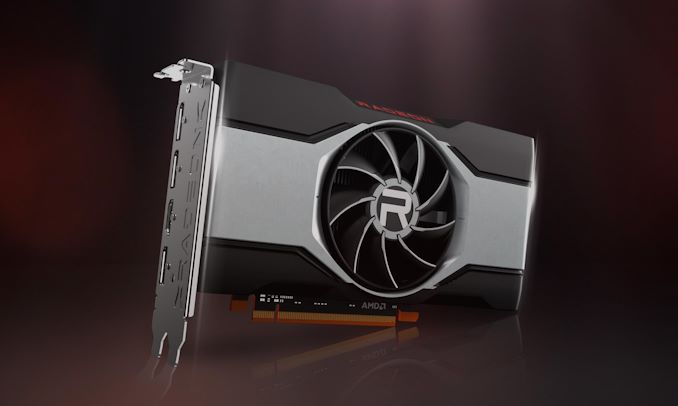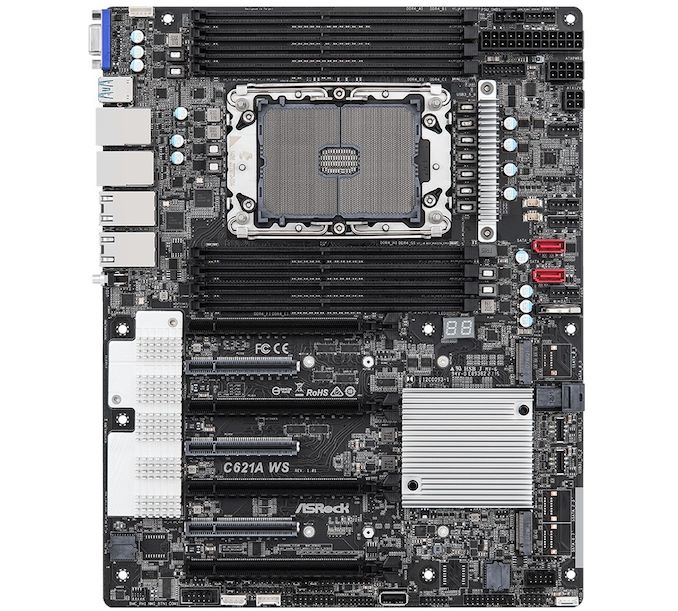Results 11,221 to 11,230 of 12096
Thread: Anandtech News
-
07-29-21, 12:57 PM #11221
Anandtech: Intel Launches Xeon W-3300: Ice Lake for Workstations, up to 38 Cores
With the launch earlier this year of Intel’s Ice Lake Xeon Scalable platform, the first Intel enterprise platform based on 10nm, we were always wondering to what extent this silicon would penetrate other markets. Today Intel is answering that question by launching the Xeon W-3300 family, using the same Ice Lake Xeon silicon but in a more focused single socket platform. Xeon W-3300 will offer processors from 12 core up to 38 cores, peaking at 270 W TDP, but offering support for up to 4 TB of memory.
More...
-
07-30-21, 01:27 AM #11222
Anandtech: AMD Announces Radeon RX 6600 XT: Mainstream RDNA2 Lands August 11th For $3
Starting next month, AMD’s Radeon RX 6000 desktop product stack is about to get a little deeper – and a little cheaper – with the addition of the forthcoming Radeon RX 6600 XT. Announced this evening, the Radeon RX 6600 XT is the next step down in the RDNA2-based Radeon lineup, adding a card aimed at mainstream, 1080p gamers. The card will offer 32 CUs’ worth of GPU hardware along with 8GB of GDDR6 memory, and will go on sale on August 11th with prices starting at $379.
The addition of the RX 6600 XT to their desktop lineup has been a long-time coming, as even though the company is already 4 cards deep into their product stack – most recently adding the 1440p-focused RX 6700 XT nearly 5 months ago – AMD hasn’t been offering a mainstream-focused RDNA2 desktop video card until now. In fact, AMD’s been pretty absent from the mainstream 1080p gaming market as a whole over the last several months, as the capacity-constrained company has been focusing its GPU manufacturing resources on laptop parts and the high-end RDNA2 chips. But finally, and at last, it’s time for the 1080p market to get a much-needed boost from AMD’s RDNA2 architecture.
Underpinning AMD’s new 1080p video card is a GPU we’ve already seen once before: Navi 23. This GPU was first employed back in May as the Radeon RX 6600M, the cornerstone of AMD’s Radeon RX 6000 mobile lineup. Now that the laptop market has had a chance to stock up on Navi 23 hardware, the GPU is making its desktop debut in the aptly named RX 6600 XT. And, unlike the RX 6600M, the RX 6600 XT will feature a fully-enabled version of the chip, giving Navi 23 its first chance to completely show off what it’s capable of.
More...
-
07-30-21, 08:32 AM #11223
Anandtech: The ZTE Axon 30 Ultra Review - Something Surprisingly Different
ZTE is one of the rare vendors active in the US market, which makes the new Axon 30 Ultra a quite interesting device that’s surprisingly viable in the current flagship landscape. At $749 it makes the right compromises.
More...
-
07-30-21, 06:29 PM #11224
Anandtech: ASRock Unveils C621A WS Motherboard, Designed for Xeon W-3300 Workstations
On the back of Intel's recent Ice Lake Xeon W-3300 announcement, ASRock has announced one of the first motherboards to support the new processors, the ASRock C621A WS. Some of its core features include four full-length PCIe 4.0 slots, three full-length PCIe 3.0 slots, two M.2 slots, eight memory slots with support for up to 2TB of DDR4 memory, and dual 10 Gb plus dual Gigabit Ethernet on the rear panel.
The latest iteration of Intel's 3rd generation Xeon Scalable platform comes via the Xeon W-3300 family, which is essentially Ice Lake for workstations. The top SKU, Xeon W-3375, contains 38 cores (76 threads), with a base frequency of 2.5 GHz, 57 MB of L3 cache, and a maximum TDP of 270 W. All of Intel's Xeon W-3300 family includes 64 PCIe 4.0 lanes, up to eight-channel DDR4, and support for up to 256 GM LRDIMMs with a maximum capacity of up to 4 TB per socket.
The ASRock C621A WS motherboard uses a transposed single LGA4189 socket and is flanked by eight horizontally mounted memory slots. There's support for up to DDR4 DIMMs at speeds up to 3200 MT/s, with a maximum capacity of up to 2 TB, with RDIMM, LRDIMM, and 3DXP memory types all supported. Dominating the lower section of the board are four full-length PCIe 4.0 x16 slots and three full-length PCIe 3.0 x8 slots, with one PCIe 3.0 x4/SATA M.2 slot and one PCIe 3.0 x1/SATA M.2 slot. For conventional SATA devices, ASRock includes two SATA ports with one mini-SAS HD connector.
As for network connectivity, ASRock includes a pair of 10 GbE that are powered by an Intel X710-ATX Ethernet controller, as well as another pair of Gigabit Ethernet ports driven by a pair of Intel I210 controllers. Other connectivity includes a D-sub video output which allows users to access the board's BMC functionality, which is provided via an ASPEED AST2500 controller, with a dedicated Ethernet port allowing for remote access to the BMC. In terms of USB, there are four USB 3.2 G1 Type-A ports on the rear panel, with further expansion available through internal headers. This includes room to installed up to four USB 3.2 G2 Type-C ports through front panel headers, one USB 3.2 G1 Type-A header for two ports, and one USB 2.0 header, which also can support another two ports.
Although the new Intel Xeon W-3300 family of processors includes native support for Thunderbolt 4 and Intel's Wi-Fi 6E CNVi, ASRock has opted not to use either of these features. Whether this is intentional from ASRock remains to be seen, as it may release more variants later. At the time of writing, ASRock hasn't given pricing information, but we expect the C621A WS to be available in retail channels soon.
Gallery: ASRock Unveils C621A WS Motherboard, Designed for Workstation_thumb.jpg)
_thumb.jpg)
_thumb.jpg)
_thumb.jpg)
_thumb.jpg)
Related Reading- Intel Launches Xeon W-3300: Ice Lake for Workstations, up to 38 Cores
- Supermicro Ultra SYS-120U-TNR Review: Testing Dual 10nm Ice Lake Xeon in 1U
- Update on Intel Sapphire Rapids in 2022: Q1 for Production, Q2 for Ramp, H1 Launch
- DIY on Intel Ice Lake Xeon Just Got A Little Closer
More...
-
08-01-21, 02:28 PM #11225
Anandtech: Intel Executive Posts Thunderbolt 5 Photo then Deletes It: 80 Gbps and PAM
An executive visiting various research divisions across the globe isn’t necessarily new, but with a focus on social media driving named individuals at each company to keep their followers sitting on the edge of their seats means that we get a lot more insights into how these companies operate. The downside of posting to social media is when certain images exposing unreleased information are not vetted by PR or legal, and we get a glimpse into the next generation of technology. That is what happened today.
More...
-
08-02-21, 01:36 PM #11226
Anandtech: Google Teases Pixel 6 and Pixel 6 Pro with new "Tensor" SoC
Today Google has teased its new upcoming Pixel 6 and Pixel 6 Pro phones; in what is likely an attempt to get leaks and the upcoming narrative of the product under control, as opposed to the previous years of quite severe product spoilers several months ahead of the actual official product launches, the company is themselves revealing large important bits about the upcoming new flagship phones.
Google reveals that this year’s Pixel phones will be called the Pixel 6 and the Pixel 6 Pro, two seemingly similarly sized devices in a high-end configuration with some compromises, and one in an all-bells-and-whistles uncompromising device. In a more exclusive prebriefing with The Verge, it’s stated that the new devices will be truly flagship specced phones competing at the highest end of the market, marking an important step away from the mid-range of the last several years. This is a large shift for Google and has been one of our main criticisms over the last few years – a seeming lack of clear direction where Google wants to be with their Pixel phones, at least until now.
The first big news and confirmation from Google is the fact that the new Pixel 6 phones will be powered by a custom SoC that Google has dubbed the “Google Tensor”. For a few years now it had been rumoured that Google would be the first customer of Samsung LSI’s new semi-custom SoC business – essentially a design and manufacture for hire service that would allow OEMs to work very closely with SLSI in designing differentiated products. Essentially this would be the exact same business model AMD uses in partnership with the console vendors.
What’s interesting here is exactly what’s part Google, and what’s part Samsung LSI and stemming off from the Exynos SoC line-up. The one thing that had been assumed and has been confirmed today is that Google is employing their own AI/ML/NPU IP in the new chip, basically leveraging the company’s experience off their datacentre TPU hardware designs and IP, and integrating it into an SoC. In a sense, this also might be a successor to the Pixel Visual Core, with the large power efficiency and cost savings advantage that Google is now able to integrate it into the primary SoC.
In terms of other specifications of the SoC, there were no further details revealed at this time, but generally given the expected fall release date of the devices, it’s generally to be assumed that the chip would feature the same generation IP blocks in terms of CPU and GPU as other 2021 SoCs such as the Exynos 2100. This wouldn’t be a complete move away from past Pixel device’s release schedule not matching the industry’s IP release cadence – I would still expect the Q1 2022 SoCs to vastly out-spec it, but it’s at least a large improvement thanks to the new hardware differentiation.
The one large question that remains to see is how things play is in terms of the cellular capabilities – notably the device dropping Qualcomm as the preferred chipset vendor would also mean that this would be the only second other design besides Qualcomm featuring mmWave connectivity, which will be interesting to see. Samsung had noted back in 2019 that they had mmWave modules, and although we didn’t see them in 2020, maybe the new Pixel phones will be the first to feature them.
In terms of the actual Pixel 6 phones, the Pixel 6 is advertised as having a 6.4” screen at a presumably lower FHD+ resolution, with flat glass design, while the Pixel 6 Pro is a 6.7” phone and a presumably QHD+ resolution. Both screens are reportedly 120Hz refresh rate as per the The Verge, though Marques Brownlee notes 90Hz on the regular unit.Material You will be best on #Pixel6.— Made By Google (@madebygoogle) August 2, 2021
The colors, the camera, the form, and what’s on the screen all work together in a single, fluid experience.
(9/13) pic.twitter.com/K6BRF9ZKEY
The design of the new Pixels is defined by what Google describes as the “camera bar”, which is an interesting take on merging the needed camera bump and embracing it into the phone’s design. The large feature is very much unapologetic and horizontally covers the width of the phone, being rounded off to the sides. It somewhat reminds me of the Mi 11 Ultra bump, just much thinner and more subdued.
In terms of cameras, both phones feature an ultra-wide and a regular wide-angle, both with new sensors that are advertised to have much better light gathering capabilities. The Pixel 6 Pro also gets a periscope telephoto module with 4x optical magnification, meaning it’ll end up around 105mm equivalence. Google’s decision to go with a lower focal length here is I think extremely good as it avoids the large quality gap, and if the company employs a high-resolution sensor on the new module, it’ll still be able to have great spatial resolution at >8x magnification.
The camera software and processing are said to be extremely integrated with the new Tensor SoC and the ML IP block of the chip, enabling new features such as using HDRnet in video recording, running the same image pipelines that previously only were possible in still shots.
Google plans to formerly announced and launch the Pixel 6 and Pixel 6 Pro “this fall”.
More...
-
08-02-21, 01:36 PM #11227
Anandtech: The GIGABYTE MZ72-HB0 (Rev 3.0) Motherboard Review: Dual Socket 3rd Gen EP
Back in March, we reviewed AMD's latest Zen 3 based EPYC 7003 processors, including the 64-core EPYC 7763 and 7713. We've updated the data back in June with a retail motherboard, and it scores much higher, showing how EPYC Milan can be refined more than it was at launch. Putting two 64-core processors into a system requires a more than capable motherboard, and today on the test bench is the GIGABYTE MZ720-HB0 (Revision 3.0), which has plenty of features to boast about. Some of the most important ones include five full-length PCIe 4.0 slots, dual 10 GbE, lots of PCIe 4.0 NVMe and SATA storage options, as well as dual SP3 sockets, and sixteen memory slots with support for up to 4 TB of capacity.
More...
-
08-03-21, 08:27 AM #11228
Re: Anandtech: AMD Ryzen 3 3300X and Ryzen 3 3100: New Low Cost Quad-Core Zen 2 Proce
Hi there, I have a question. Will AMD Ryzen 5 3600 support overclocking? and which motherboard is best X570 or B550?
-
08-03-21, 10:19 AM #11229
Anandtech: ASRock Rack Announces Two ATX Ice Lake SP Motherboards
ASRock Rack has unveiled two new motherboards designed for Intel's Ice Lake SP platform, the SPC621D8 and the SPC621D8-2L2T. Both boards feature a single LGA4189 socket design on an ATX-sized PCB, with eight memory slots supporting up to 2 TB of DDR4-3200 memory, seven PCIe 4.0 slots, and dual PCIe 3.0 M.2 slots. The SPC621D8-2L2T also gets five Ethernet ports, including dual 10 Gb Ethernet on the rear panel.
On the surface, both the ASRock Rack SPC621D8-2L2T and the SPC621D8 share the same core feature set, which includes four full-length PCIe 4.0 x16 slots and three half-length PCIe 4.0 x8 slots. Three of the full-length slots will automatically switch down to PCIe 4.0 x8 when the lower half-length slot is populated. Sitting on either side of the transposed LGA4189 socket are eight memory slots that are arranged into two banks of four. These slots can support up to 2 TB of DDR4-3200 memory, in the form of RDIMMs and LRDIMMs.
The ASRock Rack SPC621D8-2L2T and the SPC621D8 both include a varied selection of storage options, including one PCIe 3.0 x4/SATA M.2 slot and one PCIe 3.0 x1/SATA M.2 slot. The SPC621D8 has support for up to thirteen SATA ports, with six 7-pin headers included from the C621A chipset with support for RAID 0, 1, 5, and 10 arrays. The SPC621D8-2L2T has support for eight SATA ports, with the same level of RAID support. Both models include two SATA DOM headers and also include a mini-SAS HD header.
Driving the management side of things is an ASPEED AST2500 BMC controller. This can be accessed via a single D-sub video output or a dedicated management Ethernet port hooked up to a Realtek RTL8211E Gigabit controller. Both variants include various headers around the board, with some of the most notable which include a TPM header, COM header, PMBus connector, and an IPMB header. There are five 6-pin fan headers for cooling, one 24-pin 12 V ATX power input that provides power to the motherboard, and one 8-pin and one 4-pin 12 V ATX CPU power input pairing.
Both boards share a similar rear panel layout, but with one major difference. The ASRock Rack SPC621D8-2L2T includes dual 10 GbE via an Intel X710-AT2 Ethernet controller, which is on top of the two Intel I210 Gigabit controllers and the Realtek RTL8211E management LAN port that are common to both boards. Both panels include a D-sub video output for the BMC, four USB 3.2 G1 Type-A ports, and a UID indicator LED button.
We don't have pricing for either the SPC621D8-2L2T or the SPC621D8 ATX motherboards or when they will hit retail shelves at the time of writing.
Source: ASRock Rack
Gallery: ASRock Rack Announces Two ATX Ice Lake SP Motherboards_thumb.jpg)
_thumb.jpg)
_thumb.jpg)
_thumb.jpg)
_thumb.jpg)
_thumb.jpg)
Related Reading- ASRock Unveils C621A WS Motherboard, Designed for Xeon W-3300 Workstations
- Intel Launches Xeon W-3300: Ice Lake for Workstations, up to 38 Cores
- Intel 3rd Gen Xeon Scalable (Ice Lake SP) Review: Generationally Big, Competitively Small
- GIGABYTE Server: Three New E-ATX Motherboards For Intel Ice Lake-SP Xeons
More...
-
08-04-21, 01:02 PM #11230
Anandtech: The AMD Ryzen 7 5700G, Ryzen 5 5600G, and Ryzen 3 5300G Review
Earlier this year, AMD launched its Zen 3 based desktop processor solutions with integrated graphics. Marketed as the Ryzen 5000G family, these processors are the latest offering to combine AMD’s high-performing Zen 3 cores with tried-and-tested Vega 8 graphics, all built on TSMC’s 7nm process. As desktop processors, AMD made them available to system builders for a few months, allowing the company to keep track of stock levels and have a consistent demand during a high-demand phase for silicon. But on August 5th, they will be made available to buy at retail, and we’ve got the most important models to test.
More...
Thread Information
Users Browsing this Thread
There are currently 39 users browsing this thread. (0 members and 39 guests)





 Quote
Quote
a_575px.jpg)




_575px.jpg)


















Bookmarks